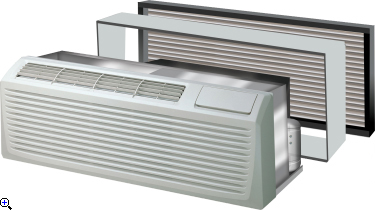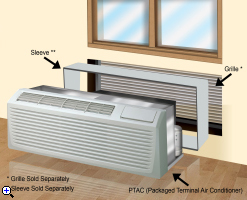What is a Packaged Terminal Air-Conditioner (PTAC)?
PTAC stands for "packaged terminal air conditioner." PTACs are single, commercial grade, self-contained units installed through a wall and often found in hotels. A PTAC's compressor system both cools and heats. To cool, the units compressor pumps refrigerant to cool the coils which attracts heat and humidity which is then exhausted to the outside. To heat, this functionality is reversed. The refrigerant is used to heat the coils, and when air passes over it the unit pushes the heated air into the room. PTACs are larger than a typical through-the-wall air conditioner; the standard size is 42" wide. PTACs are often seen in the hospitality industry and are approved for commercial use, but they are also suitable for residential applications.
How do I choose my PTAC unit?
The two most important things to keep in mind are BTUs and plug type. BTUs (British Thermal Units) BTUs are units of power - the larger the area you need to cool, the more BTUs you need. It's important to find the right size. Buying a higher BTU air conditioner than your room size requires is not recommended. It is preferred to have the correct size air conditioner run for longer to properly remove humidity from the room - learn more. Plug Type There are two parts to plug type: voltage and amperage. As a general rule the higher the amperage the higher the heating capacity. PTAC units can be plugged into a receptacle or the unit can be permanently connected (hard wired) to the building's wiring. To hard wire your PTAC you will have to purchase a permanent connection kit (also called a sub base kit) separately. If you are replacing an existing unit, choose a PTAC with same plug type to determine the right amount of amperage and voltage.
What are the pros and cons of a PTAC unit?
PTAC units are beneficial because they can efficiently cool and heat a room from a single unit. PTACs are commercial grade durable units, but since they are units 42" wide you have to have a large hole cut into your wall. PTACs have to be installed into an external sleeve with an exterior grille that are both sold separately. PTAC units are generally more expensive than window air conditioners, but if you are planning to both cool and heat a room then you could save up to 20% a year on electricity.

How does the heater in a PTAC work?
PTACs can have two types of heat: heap pump or electric heat. Heat Pump (reverse cycle) The heat pump reverses the cooling cycle on the air conditioner. The refrigerant is used to heat the coils, and after the air passes over the hot coils the heated air is pushed back into the room. This type of heat will work up until it is 40 degrees Fahrenheit outside and is ideal for warmer climates. Most PTAC units with a heat pump will come with electric heat back up for cooler winter temperatures.
Electric Heat Units with electric heat will have an additional heating element near the vents that is heated using electricity. The air is heated when it passes over the element. Units with electric heat generally last longer than the heat pump types and are quieter, but are not as energy efficient.
What types of accessories do I need to install a PTAC unit?
All PTAC units require purchasing a grille and a sleeve (unless you are replacing an existing model and your sleeve and grille are still in good shape). Other accessories such as drain kits, hard wiring connections, remote controls and wall thermostats are also available and are usually sold separately.
